Abstract
The cytotoxic T lymphocyte (CTL) activity of spleen cells from BALB/c (H-2d) mice immunized with the neurotropic JHM strain of mouse hepatitis virus (JHMV) was stimulated in vitro for 7 days. CTL were tested for recognition of target cells infected with either JHMV or vaccinia virus recombinants expressing the four virus structural proteins. Only target cells infected with either JHMV or the vaccinia virus recombinant expressing the JHMV nucleocapsid protein were recognized. Cytotoxic T cell lines were established by limiting dilution from the brains of mice undergoing acute demyelinating encephalomyelitis after infection with JHMV. Twenty of the 22 lines recognized JHMV-infected but not uninfected syngeneic target cells, indicating that they are specific for JHMV. All T-cell lines except one were CD8+. The specificity of the CTL lines was examined by using target cells infected with vaccinia virus recombinants expressing the JHMV nucleocapsid, spike, membrane, and hemagglutinin-esterase structural proteins. Seventeen lines recognized target cells expressing the nucleocapsid protein. Three of the JHMV-specific T-cell lines were unable to recognize target cells expressing any of the JHMV structural proteins, indicating that they are specific for an epitope of a nonstructural protein(s) of JHMV. These data indicate that the nucleocapsid protein induces an immunodominant CTL response. However, no CTL activity specific for the nucleocapsid protein could be detected in either the spleens or cervical lymph nodes of mice 4, 5, 6, or 7 days after intracranial infection, suggesting that the CTL response to JHMV infection within the central nervous system may be induced or expanded locally.
Full text
PDF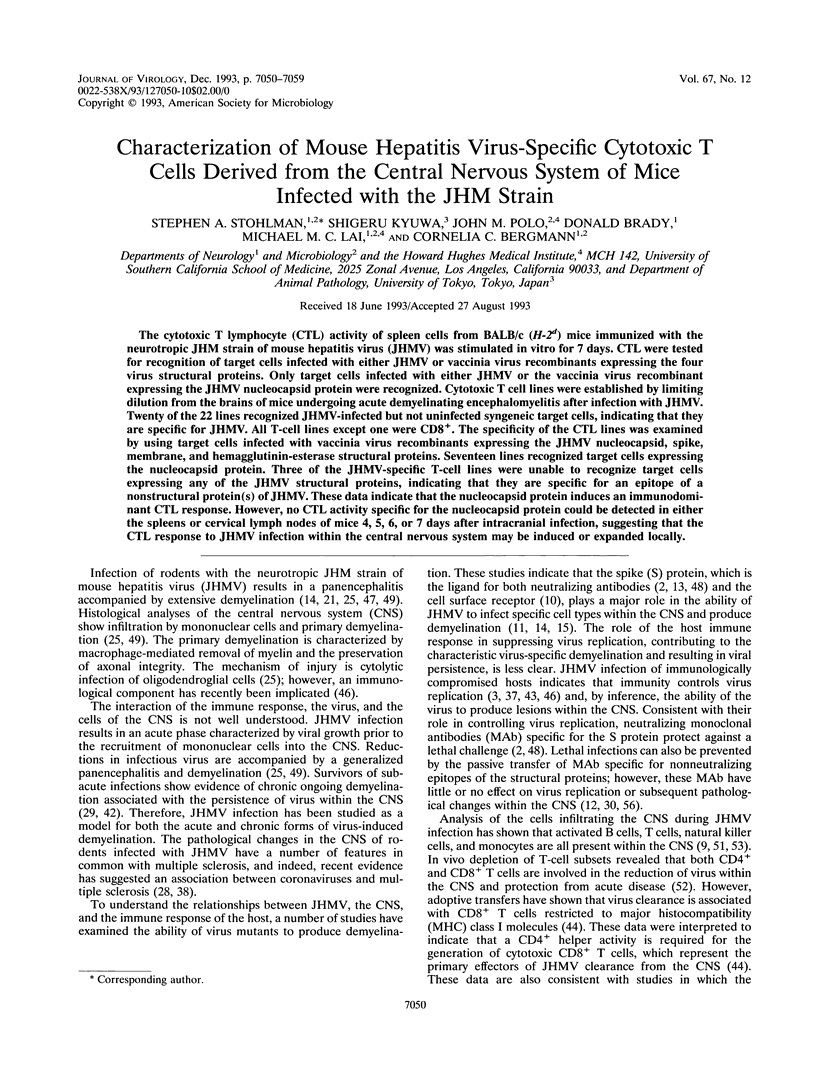
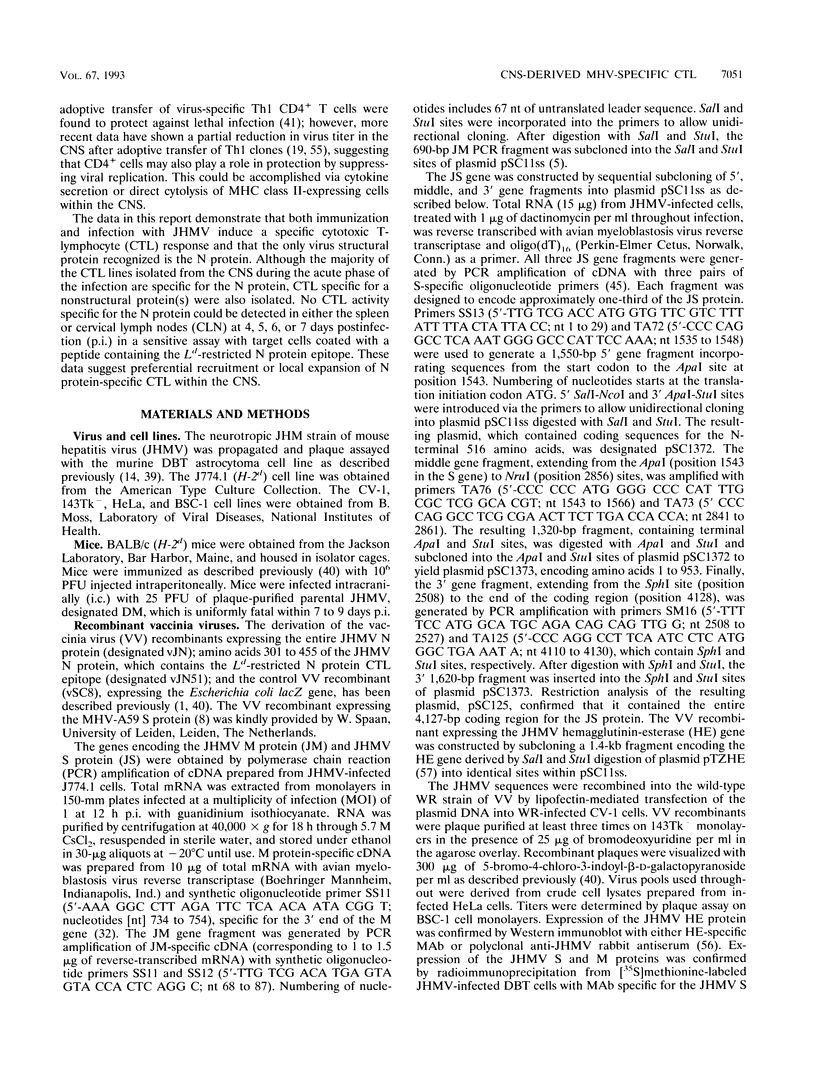
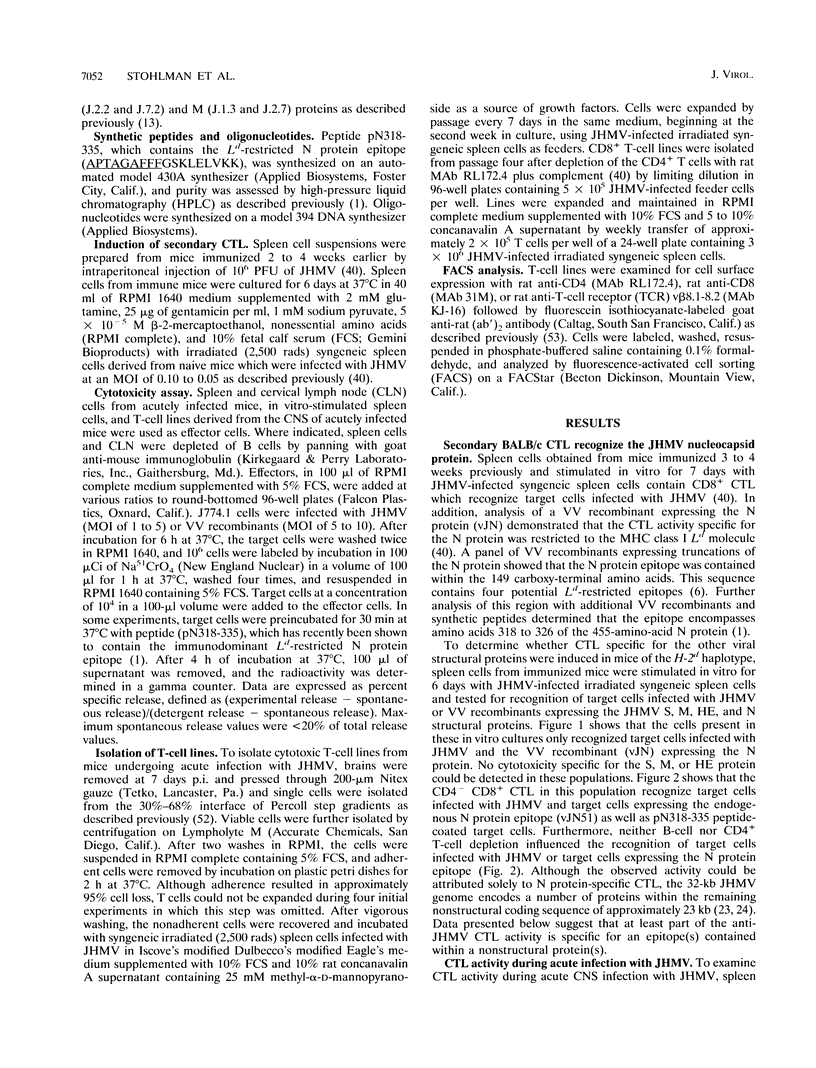
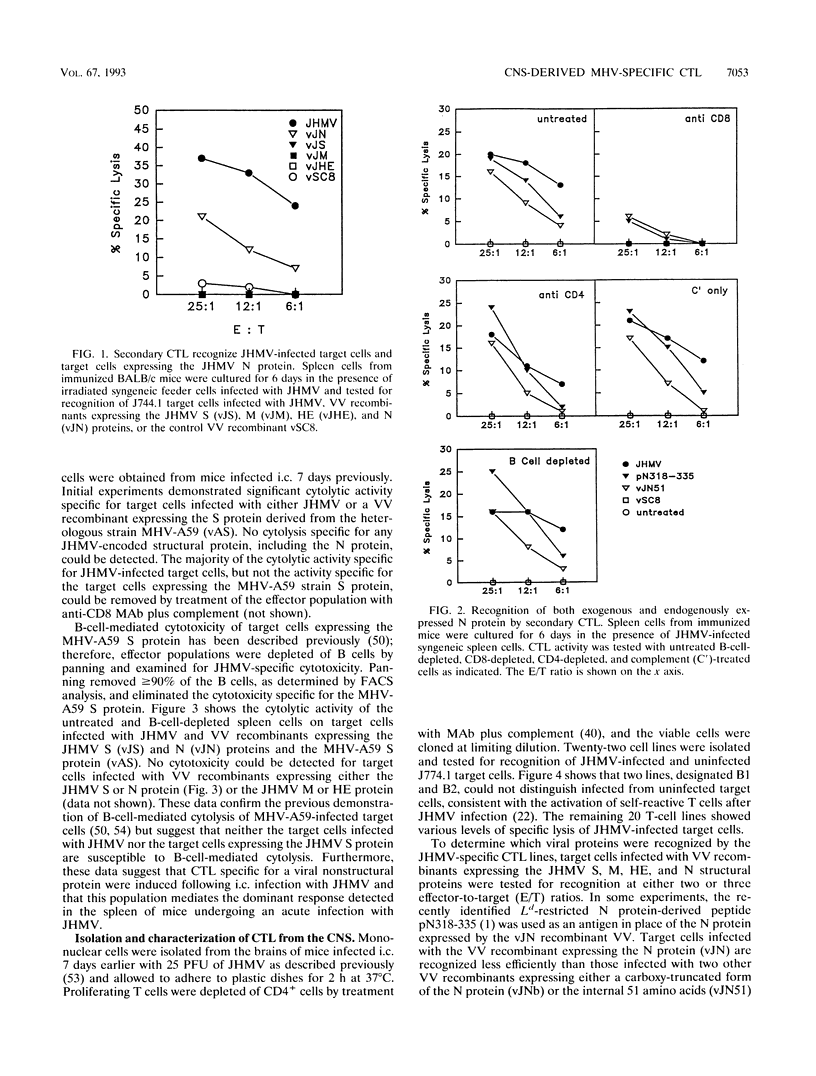
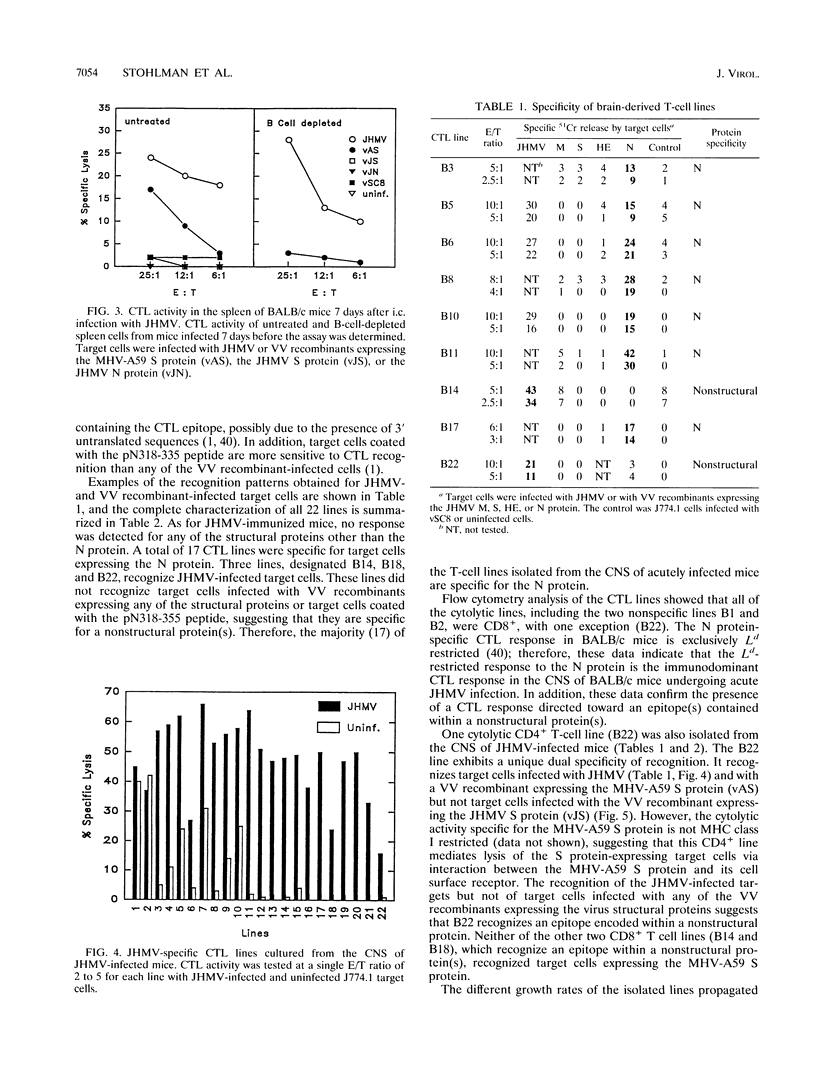
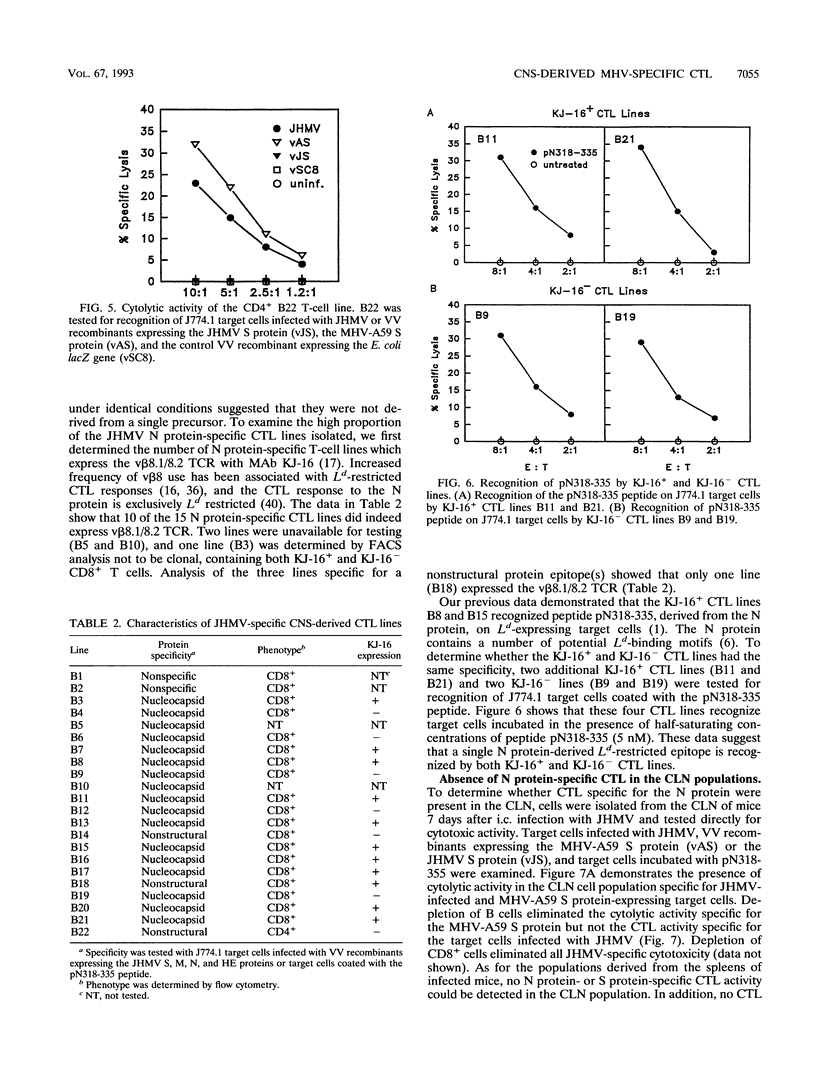
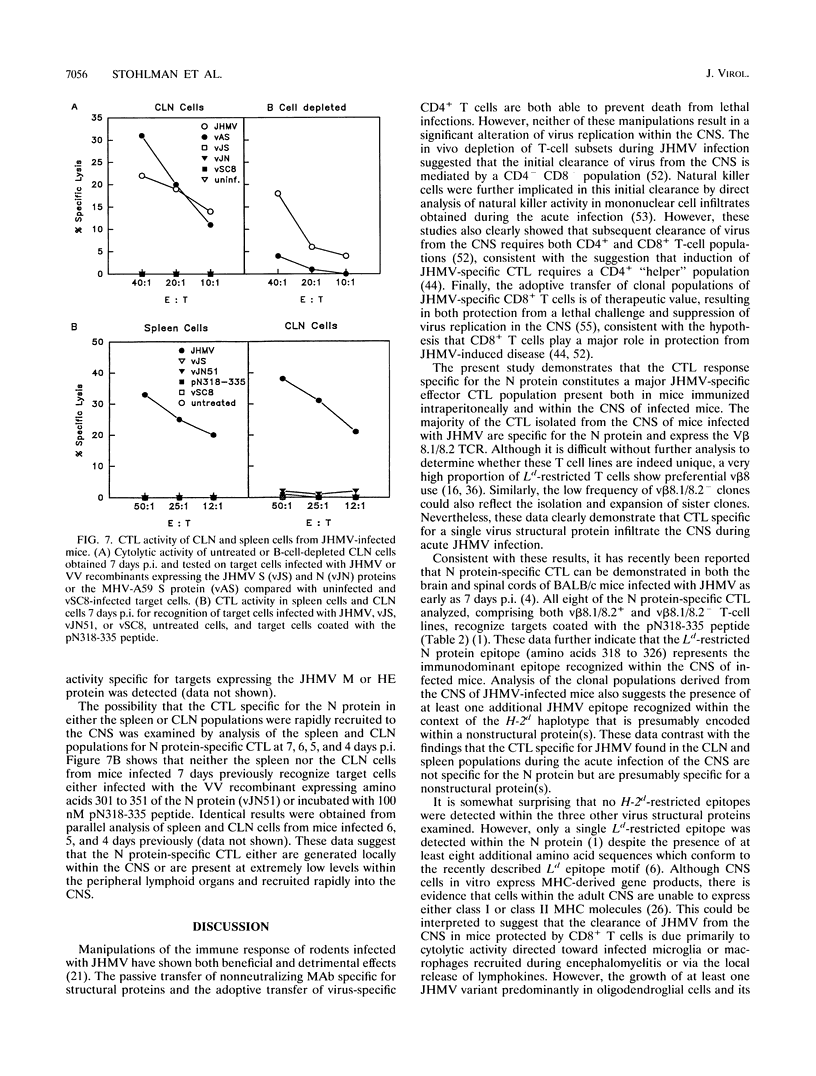
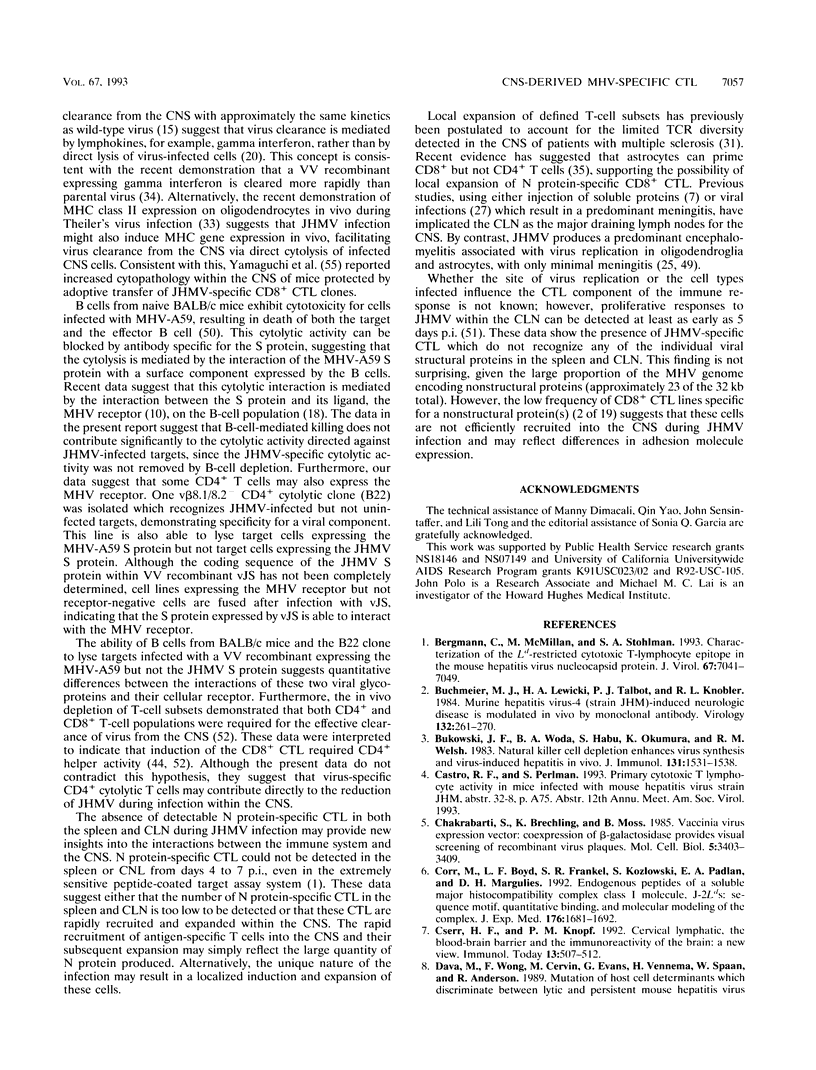
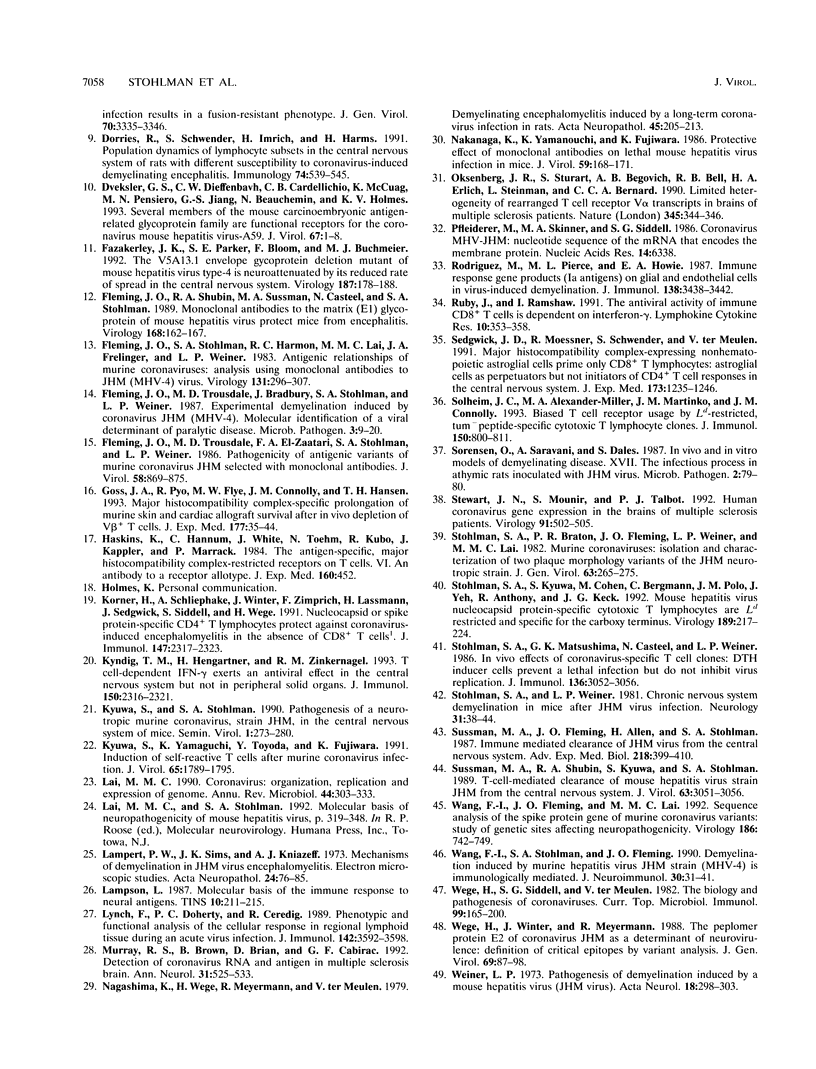
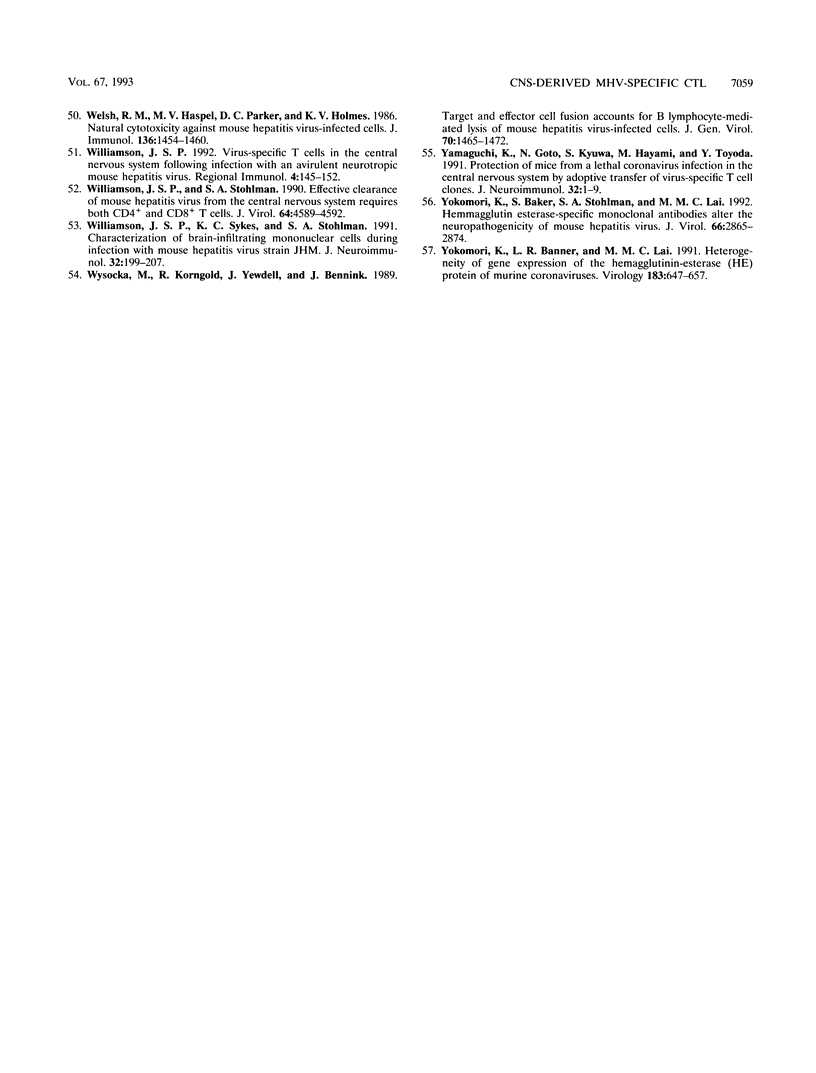
Selected References
These references are in PubMed. This may not be the complete list of references from this article.
- Bergmann C., McMillan M., Stohlman S. Characterization of the Ld-restricted cytotoxic T-lymphocyte epitope in the mouse hepatitis virus nucleocapsid protein. J Virol. 1993 Dec;67(12):7041–7049. doi: 10.1128/jvi.67.12.7041-7049.1993. [DOI] [PMC free article] [PubMed] [Google Scholar]
- Buchmeier M. J., Lewicki H. A., Talbot P. J., Knobler R. L. Murine hepatitis virus-4 (strain JHM)-induced neurologic disease is modulated in vivo by monoclonal antibody. Virology. 1984 Jan 30;132(2):261–270. doi: 10.1016/0042-6822(84)90033-3. [DOI] [PMC free article] [PubMed] [Google Scholar]
- Bukowski J. F., Woda B. A., Habu S., Okumura K., Welsh R. M. Natural killer cell depletion enhances virus synthesis and virus-induced hepatitis in vivo. J Immunol. 1983 Sep;131(3):1531–1538. [PubMed] [Google Scholar]
- Chakrabarti S., Brechling K., Moss B. Vaccinia virus expression vector: coexpression of beta-galactosidase provides visual screening of recombinant virus plaques. Mol Cell Biol. 1985 Dec;5(12):3403–3409. doi: 10.1128/mcb.5.12.3403. [DOI] [PMC free article] [PubMed] [Google Scholar]
- Corr M., Boyd L. F., Frankel S. R., Kozlowski S., Padlan E. A., Margulies D. H. Endogenous peptides of a soluble major histocompatibility complex class I molecule, H-2Lds: sequence motif, quantitative binding, and molecular modeling of the complex. J Exp Med. 1992 Dec 1;176(6):1681–1692. doi: 10.1084/jem.176.6.1681. [DOI] [PMC free article] [PubMed] [Google Scholar]
- Cserr H. F., Knopf P. M. Cervical lymphatics, the blood-brain barrier and the immunoreactivity of the brain: a new view. Immunol Today. 1992 Dec;13(12):507–512. doi: 10.1016/0167-5699(92)90027-5. [DOI] [PubMed] [Google Scholar]
- Dveksler G. S., Dieffenbach C. W., Cardellichio C. B., McCuaig K., Pensiero M. N., Jiang G. S., Beauchemin N., Holmes K. V. Several members of the mouse carcinoembryonic antigen-related glycoprotein family are functional receptors for the coronavirus mouse hepatitis virus-A59. J Virol. 1993 Jan;67(1):1–8. doi: 10.1128/jvi.67.1.1-8.1993. [DOI] [PMC free article] [PubMed] [Google Scholar]
- Dörries R., Schwender S., Imrich H., Harms H. Population dynamics of lymphocyte subsets in the central nervous system of rats with different susceptibility to coronavirus-induced demyelinating encephalitis. Immunology. 1991 Nov;74(3):539–545. [PMC free article] [PubMed] [Google Scholar]
- Fazakerley J. K., Parker S. E., Bloom F., Buchmeier M. J. The V5A13.1 envelope glycoprotein deletion mutant of mouse hepatitis virus type-4 is neuroattenuated by its reduced rate of spread in the central nervous system. Virology. 1992 Mar;187(1):178–188. doi: 10.1016/0042-6822(92)90306-A. [DOI] [PMC free article] [PubMed] [Google Scholar]
- Fleming J. O., Shubin R. A., Sussman M. A., Casteel N., Stohlman S. A. Monoclonal antibodies to the matrix (E1) glycoprotein of mouse hepatitis virus protect mice from encephalitis. Virology. 1989 Jan;168(1):162–167. doi: 10.1016/0042-6822(89)90415-7. [DOI] [PMC free article] [PubMed] [Google Scholar]
- Fleming J. O., Stohlman S. A., Harmon R. C., Lai M. M., Frelinger J. A., Weiner L. P. Antigenic relationships of murine coronaviruses: analysis using monoclonal antibodies to JHM (MHV-4) virus. Virology. 1983 Dec;131(2):296–307. doi: 10.1016/0042-6822(83)90498-1. [DOI] [PMC free article] [PubMed] [Google Scholar]
- Fleming J. O., Trousdale M. D., Bradbury J., Stohlman S. A., Weiner L. P. Experimental demyelination induced by coronavirus JHM (MHV-4): molecular identification of a viral determinant of paralytic disease. Microb Pathog. 1987 Jul;3(1):9–20. doi: 10.1016/0882-4010(87)90033-7. [DOI] [PMC free article] [PubMed] [Google Scholar]
- Fleming J. O., Trousdale M. D., el-Zaatari F. A., Stohlman S. A., Weiner L. P. Pathogenicity of antigenic variants of murine coronavirus JHM selected with monoclonal antibodies. J Virol. 1986 Jun;58(3):869–875. doi: 10.1128/jvi.58.3.869-875.1986. [DOI] [PMC free article] [PubMed] [Google Scholar]
- Goss J. A., Pyo R., Flye M. W., Connolly J. M., Hansen T. H. Major histocompatibility complex-specific prolongation of murine skin and cardiac allograft survival after in vivo depletion of V beta+ T cells. J Exp Med. 1993 Jan 1;177(1):35–44. doi: 10.1084/jem.177.1.35. [DOI] [PMC free article] [PubMed] [Google Scholar]
- Haskins K., Hannum C., White J., Roehm N., Kubo R., Kappler J., Marrack P. The antigen-specific, major histocompatibility complex-restricted receptor on T cells. VI. An antibody to a receptor allotype. J Exp Med. 1984 Aug 1;160(2):452–471. doi: 10.1084/jem.160.2.452. [DOI] [PMC free article] [PubMed] [Google Scholar]
- Kyuwa S., Yamaguchi K., Toyoda Y., Fujiwara K. Induction of self-reactive T cells after murine coronavirus infection. J Virol. 1991 Apr;65(4):1789–1795. doi: 10.1128/jvi.65.4.1789-1795.1991. [DOI] [PMC free article] [PubMed] [Google Scholar]
- Körner H., Schliephake A., Winter J., Zimprich F., Lassmann H., Sedgwick J., Siddell S., Wege H. Nucleocapsid or spike protein-specific CD4+ T lymphocytes protect against coronavirus-induced encephalomyelitis in the absence of CD8+ T cells. J Immunol. 1991 Oct 1;147(7):2317–2323. [PubMed] [Google Scholar]
- Kündig T. M., Hengartner H., Zinkernagel R. M. T cell-dependent IFN-gamma exerts an antiviral effect in the central nervous system but not in peripheral solid organs. J Immunol. 1993 Mar 15;150(6):2316–2321. [PubMed] [Google Scholar]
- Lai M. M. Coronavirus: organization, replication and expression of genome. Annu Rev Microbiol. 1990;44:303–333. doi: 10.1146/annurev.mi.44.100190.001511. [DOI] [PubMed] [Google Scholar]
- Lampert P. W., Sims J. K., Kniazeff A. J. Mechanism of demyelination in JHM virus encephalomyelitis. Electron microscopic studies. Acta Neuropathol. 1973 Mar 30;24(1):76–85. doi: 10.1007/BF00691421. [DOI] [PMC free article] [PubMed] [Google Scholar]
- Lynch F., Doherty P. C., Ceredig R. Phenotypic and functional analysis of the cellular response in regional lymphoid tissue during an acute virus infection. J Immunol. 1989 May 15;142(10):3592–3598. [PubMed] [Google Scholar]
- Murray R. S., Brown B., Brian D., Cabirac G. F. Detection of coronavirus RNA and antigen in multiple sclerosis brain. Ann Neurol. 1992 May;31(5):525–533. doi: 10.1002/ana.410310511. [DOI] [PMC free article] [PubMed] [Google Scholar]
- Nagashima K., Wege H., Meyermann R., ter Meulen V. Demyelinating encephalomyelitis induced by a long-term corona virus infection in rats. A preliminary report. Acta Neuropathol. 1979 Mar 15;45(3):205–213. doi: 10.1007/BF00702672. [DOI] [PMC free article] [PubMed] [Google Scholar]
- Nakanaga K., Yamanouchi K., Fujiwara K. Protective effect of monoclonal antibodies on lethal mouse hepatitis virus infection in mice. J Virol. 1986 Jul;59(1):168–171. doi: 10.1128/jvi.59.1.168-171.1986. [DOI] [PMC free article] [PubMed] [Google Scholar]
- Oksenberg J. R., Stuart S., Begovich A. B., Bell R. B., Erlich H. A., Steinman L., Bernard C. C. Limited heterogeneity of rearranged T-cell receptor V alpha transcripts in brains of multiple sclerosis patients. Nature. 1990 May 24;345(6273):344–346. doi: 10.1038/345344a0. [DOI] [PubMed] [Google Scholar]
- Pfleiderer M., Skinner M. A., Siddell S. G. Coronavirus MHV-JHM: nucleotide sequence of the mRNA that encodes the membrane protein. Nucleic Acids Res. 1986 Aug 11;14(15):6338–6338. doi: 10.1093/nar/14.15.6338. [DOI] [PMC free article] [PubMed] [Google Scholar]
- Rodriguez M., Pierce M. L., Howie E. A. Immune response gene products (Ia antigens) on glial and endothelial cells in virus-induced demyelination. J Immunol. 1987 May 15;138(10):3438–3442. [PubMed] [Google Scholar]
- Ruby J., Ramshaw I. The antiviral activity of immune CD8+ T cells is dependent on interferon-gamma. Lymphokine Cytokine Res. 1991 Oct;10(5):353–358. [PubMed] [Google Scholar]
- Sedgwick J. D., Mössner R., Schwender S., ter Meulen V. Major histocompatibility complex-expressing nonhematopoietic astroglial cells prime only CD8+ T lymphocytes: astroglial cells as perpetuators but not initiators of CD4+ T cell responses in the central nervous system. J Exp Med. 1991 May 1;173(5):1235–1246. doi: 10.1084/jem.173.5.1235. [DOI] [PMC free article] [PubMed] [Google Scholar]
- Solheim J. C., Alexander-Miller M. A., Martinko J. M., Connolly J. M. Biased T cell receptor usage by Ld-restricted, tum- peptide-specific cytotoxic T lymphocyte clones. J Immunol. 1993 Feb 1;150(3):800–811. [PubMed] [Google Scholar]
- Sorensen O., Saravani A., Dales S. In vivo and in vitro models of demyelinating disease. XVII. The infectious process in athymic rats inoculated with JHM virus. Microb Pathog. 1987 Feb;2(2):79–90. doi: 10.1016/0882-4010(87)90100-8. [DOI] [PMC free article] [PubMed] [Google Scholar]
- Stewart J. N., Mounir S., Talbot P. J. Human coronavirus gene expression in the brains of multiple sclerosis patients. Virology. 1992 Nov;191(1):502–505. doi: 10.1016/0042-6822(92)90220-J. [DOI] [PMC free article] [PubMed] [Google Scholar]
- Stohlman S. A., Brayton P. R., Fleming J. O., Weiner L. P., Lai M. M. Murine coronaviruses: isolation and characterization of two plaque morphology variants of the JHM neurotropic strain. J Gen Virol. 1982 Dec;63(2):265–275. doi: 10.1099/0022-1317-63-2-265. [DOI] [PubMed] [Google Scholar]
- Stohlman S. A., Kyuwa S., Cohen M., Bergmann C., Polo J. M., Yeh J., Anthony R., Keck J. G. Mouse hepatitis virus nucleocapsid protein-specific cytotoxic T lymphocytes are Ld restricted and specific for the carboxy terminus. Virology. 1992 Jul;189(1):217–224. doi: 10.1016/0042-6822(92)90697-N. [DOI] [PMC free article] [PubMed] [Google Scholar]
- Stohlman S. A., Matsushima G. K., Casteel N., Weiner L. P. In vivo effects of coronavirus-specific T cell clones: DTH inducer cells prevent a lethal infection but do not inhibit virus replication. J Immunol. 1986 Apr 15;136(8):3052–3056. [PubMed] [Google Scholar]
- Stohlman S. A., Weiner L. P. Chronic central nervous system demyelination in mice after JHM virus infection. Neurology. 1981 Jan;31(1):38–44. doi: 10.1212/wnl.31.1.38. [DOI] [PubMed] [Google Scholar]
- Sussman M. A., Fleming J. O., Allen H., Stohlman S. A. Immune mediated clearance of JHM virus from the central nervous system. Adv Exp Med Biol. 1987;218:399–410. doi: 10.1007/978-1-4684-1280-2_49. [DOI] [PubMed] [Google Scholar]
- Sussman M. A., Shubin R. A., Kyuwa S., Stohlman S. A. T-cell-mediated clearance of mouse hepatitis virus strain JHM from the central nervous system. J Virol. 1989 Jul;63(7):3051–3056. doi: 10.1128/jvi.63.7.3051-3056.1989. [DOI] [PMC free article] [PubMed] [Google Scholar]
- Wang F. I., Fleming J. O., Lai M. M. Sequence analysis of the spike protein gene of murine coronavirus variants: study of genetic sites affecting neuropathogenicity. Virology. 1992 Feb;186(2):742–749. doi: 10.1016/0042-6822(92)90041-M. [DOI] [PMC free article] [PubMed] [Google Scholar]
- Wang F. I., Stohlman S. A., Fleming J. O. Demyelination induced by murine hepatitis virus JHM strain (MHV-4) is immunologically mediated. J Neuroimmunol. 1990 Nov;30(1):31–41. doi: 10.1016/0165-5728(90)90050-W. [DOI] [PMC free article] [PubMed] [Google Scholar]
- Wege H., Siddell S., ter Meulen V. The biology and pathogenesis of coronaviruses. Curr Top Microbiol Immunol. 1982;99:165–200. doi: 10.1007/978-3-642-68528-6_5. [DOI] [PubMed] [Google Scholar]
- Wege H., Winter J., Meyermann R. The peplomer protein E2 of coronavirus JHM as a determinant of neurovirulence: definition of critical epitopes by variant analysis. J Gen Virol. 1988 Jan;69(Pt 1):87–98. doi: 10.1099/0022-1317-69-1-87. [DOI] [PubMed] [Google Scholar]
- Weiner L. P. Pathogenesis of demyelination induced by a mouse hepatitis. Arch Neurol. 1973 May;28(5):298–303. doi: 10.1001/archneur.1973.00490230034003. [DOI] [PubMed] [Google Scholar]
- Welsh R. M., Haspel M. V., Parker D. C., Holmes K. V. Natural cytotoxicity against mouse hepatitis virus-infected cells. II. A cytotoxic effector cell with a B lymphocyte phenotype. J Immunol. 1986 Feb 15;136(4):1454–1460. [PubMed] [Google Scholar]
- Williamson J. S., Stohlman S. A. Effective clearance of mouse hepatitis virus from the central nervous system requires both CD4+ and CD8+ T cells. J Virol. 1990 Sep;64(9):4589–4592. doi: 10.1128/jvi.64.9.4589-4592.1990. [DOI] [PMC free article] [PubMed] [Google Scholar]
- Williamson J. S., Sykes K. C., Stohlman S. A. Characterization of brain-infiltrating mononuclear cells during infection with mouse hepatitis virus strain JHM. J Neuroimmunol. 1991 Jun;32(3):199–207. doi: 10.1016/0165-5728(91)90189-E. [DOI] [PMC free article] [PubMed] [Google Scholar]
- Williamson J. S. Virus-specific T cells in the central nervous system following infection with an avirulent neurotropic mouse hepatitis virus. Reg Immunol. 1992 May-Jun;4(3):145–152. [PubMed] [Google Scholar]
- Wysocka M., Korngold R., Yewdell J., Bennink J. Target and effector cell fusion accounts for B lymphocyte-mediated lysis of mouse hepatitis virus-infected cells. J Gen Virol. 1989 Jun;70(Pt 6):1465–1472. doi: 10.1099/0022-1317-70-6-1465. [DOI] [PubMed] [Google Scholar]
- Yamaguchi K., Goto N., Kyuwa S., Hayami M., Toyoda Y. Protection of mice from a lethal coronavirus infection in the central nervous system by adoptive transfer of virus-specific T cell clones. J Neuroimmunol. 1991 Apr;32(1):1–9. doi: 10.1016/0165-5728(91)90065-F. [DOI] [PMC free article] [PubMed] [Google Scholar]
- Yokomori K., Baker S. C., Stohlman S. A., Lai M. M. Hemagglutinin-esterase-specific monoclonal antibodies alter the neuropathogenicity of mouse hepatitis virus. J Virol. 1992 May;66(5):2865–2874. doi: 10.1128/jvi.66.5.2865-2874.1992. [DOI] [PMC free article] [PubMed] [Google Scholar]
- Yokomori K., Banner L. R., Lai M. M. Heterogeneity of gene expression of the hemagglutinin-esterase (HE) protein of murine coronaviruses. Virology. 1991 Aug;183(2):647–657. doi: 10.1016/0042-6822(91)90994-M. [DOI] [PMC free article] [PubMed] [Google Scholar]


